You may have heard the terms tonic, dominant, and subdominant. And you may have heard just how fundamental these are to music theory. But I played piano for about fifteen years before I even knew what tonic, dominant, and subdominant was. So what do they mean and why should I care?
Tonic, subdominant, and dominant are the first, fourth, and fifth degrees in any scale. They are the key elements to building a song. The tonic is often referred to as “home”, while subdominant moves you to the next note, and dominant makes you want to return back home to resolve the sound. Why do we care? Because the majority of music that you will ever listen to or play, bases the entire song off of these chords. You can create, or recreate most songs when you understand tonic, dominant, and subdominant chords.
It may sound complicated, especially if you aren’t familiar with these terms. But it really is pretty simple. Here’s a simple, basic explanation that explains all you need to know about tonic, subdominant, and dominant chords. My 5 year old daughter can play and understand the basics of tonic, subdominant, and dominant and so can you!
What You Need To Know About Tonic
- How do you find the tonic?
The tonic degree, or the tonic chord, is always the easiest to find. The tonic is found by the first degree in a scale. If you are looking at the C major scale, the tonic is C. If you are working with the G major scale, the tonic is G. Simple enough, right? In fact – it is just that!
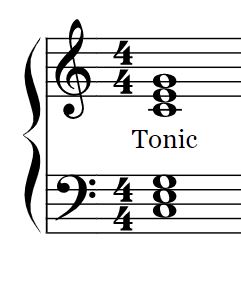
Tonic Chord for C Major
- A song will probably begin and end with the tonic.
You will often find a song begin with the tonic (or a part of the tonic chord) and end with the tonic. In this example, Jingle Bells begins and ends with the tonic chord.
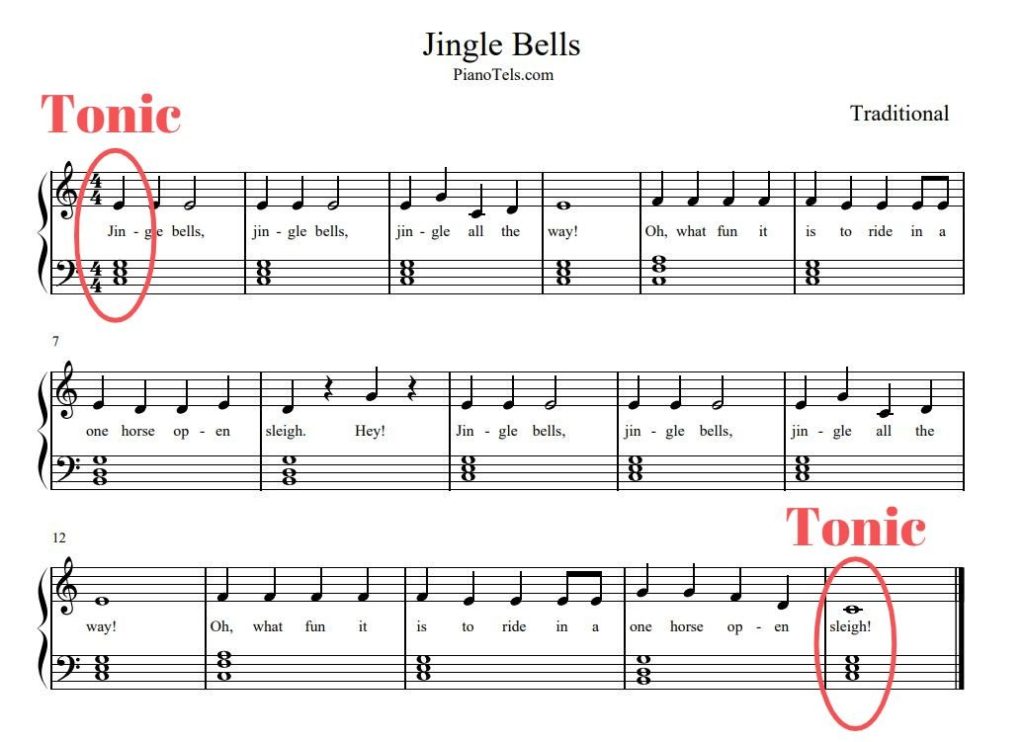
- The tonic is HOME.
The tonic is called home, because it is where we are at rest. It is where a song is resolved, and where we want to start and melody and always where we want to return to. We want to come back home with the tonic. Thus, the tonic draws back to itself.
- The tonic is symbolized with Roman numeral I if it is MAJOR. It is a Roman numeral i for a MINOR tonic chord.
Because tonic is the first degree of a scale, it is symbolized with a roman numeral I or i.
What You Need To Know About Subdominant
- How do you find the subdominant?
The subdominant is the fourth degree of a scale, or can be found 4 tones, or notes above the tonic.
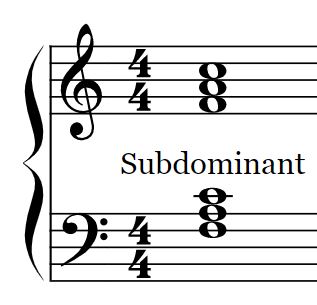
The Subdominant of the C Major Scale
- You will often see the subdominant chord as an inversion of its root chord.
Any chord, including the subdominant can be mixed around a little bit — they call these “mixed up” chords, inversions. All this means is that they simply did a little mixing of the chord, yet still use only the notes built on the fourth degree. Here’s an example. Let’s look at the subdominant chord for a C major scale. If would be F-A-C. You can take those notes, and mix them up as long as you don’t change the notes. So, let’s look at it like this: C-F-A. I just moved the C below the others. This is often the chord you will be seeing in your music for a subdominant chord. You may see the full chord, or just one or two notes of the chord.
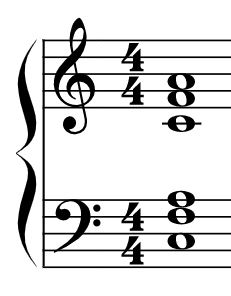
Subdominant 2nd Inversion in a C Major Scale
- The subdominant “moves” us up to the dominant.
The subdominant causes us to “leave home”. It has an almost mysterious, or unresolved feeling that causes us to draw back to the dominant. Which is why it is called sub-dominant. As such, you will often find a dominant following a subdominant chord. Check it out here:
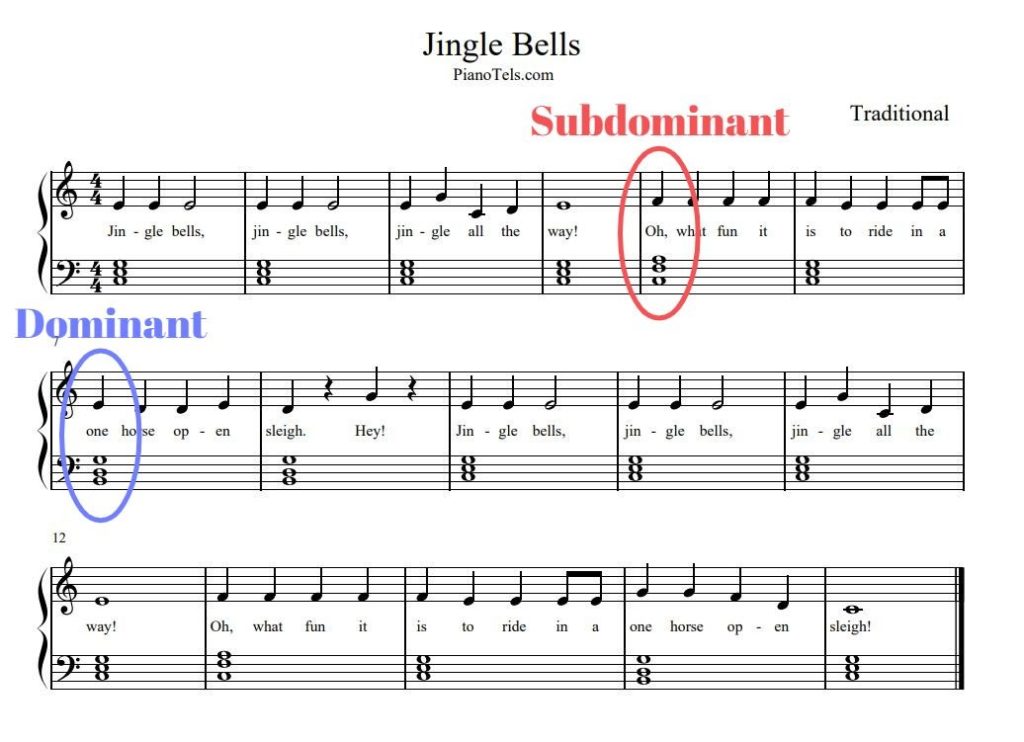
- The subdominant is symbolized with a Roman numeral IV for a MAJOR chord. It is a Roman numeral i for a MINOR subdominant chord.
Because the subdominant is the fourth degree of a scale, it is symbolized with a roman numeral IV or iv.
What You Need To Know About Dominant
- How do you find the dominant?
The dominant is the fifth degree of a scale, or can be found 5 tones, or notes above the tonic.
- You will often see the dominant chord as an inversion of its root chord.
Just like the subdominant, you will often find the dominant chord as an inversion of its root chord. Simply stated, that just means that instead of it being in this order of G-B-D, you will find it as B-D-G. Same chord, just inverted.
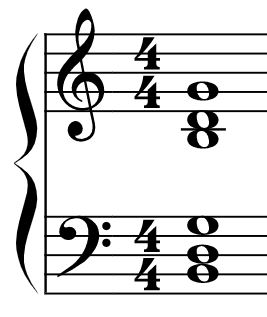
1st Inversion Dominant Chord for a C Major Scale
- The dominant leads us back to home.
The dominant chord causes tension or stress with a desire to resolve\. It almost begs us to return back home. Therefore, the dominant chord leads us back to the tonic, or to home. Just like in this example:
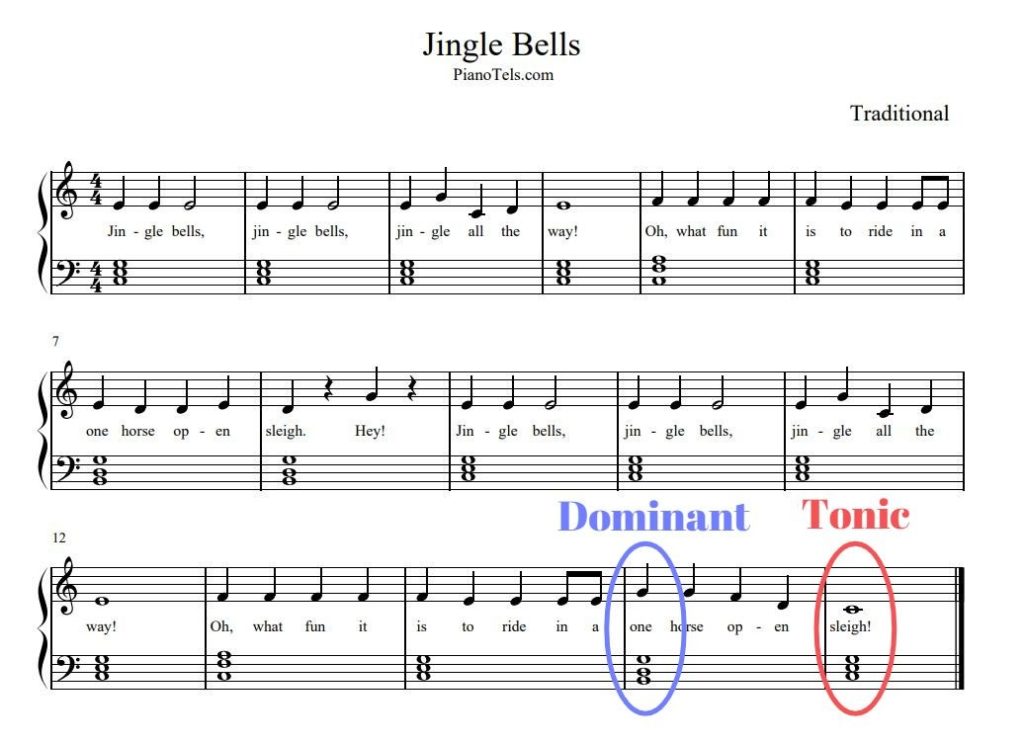
- The dominant is symbolized with a Roman numeral V for a MAJOR chord. It is a Roman numeral v for a MINOR subdominant chord.
Because it is build upon the fifth degree of a scale, it is symbolized with a Roman numeral V, or v.
How You Can Compose with Tonic, Subdominant, and Dominant
Now that you know the basics of tonic, subdominant, and dominant, you can begin to compose! Take about any song, and you will find that most of the songs are based upon the alteration of tonic, subdominant, and dominant chords. This will become your accompaniment. From there, you can just add a melody. Or you can take a melody (you can even play that by ear), and add an accompaniment of tonic, subdominant, and dominant chords.
Here’s how.
Let’s take Jingle Bells. You may know the melody to Jingle Bells already:
Jingle-Bells-PianoTels.pdf (1009 downloads )
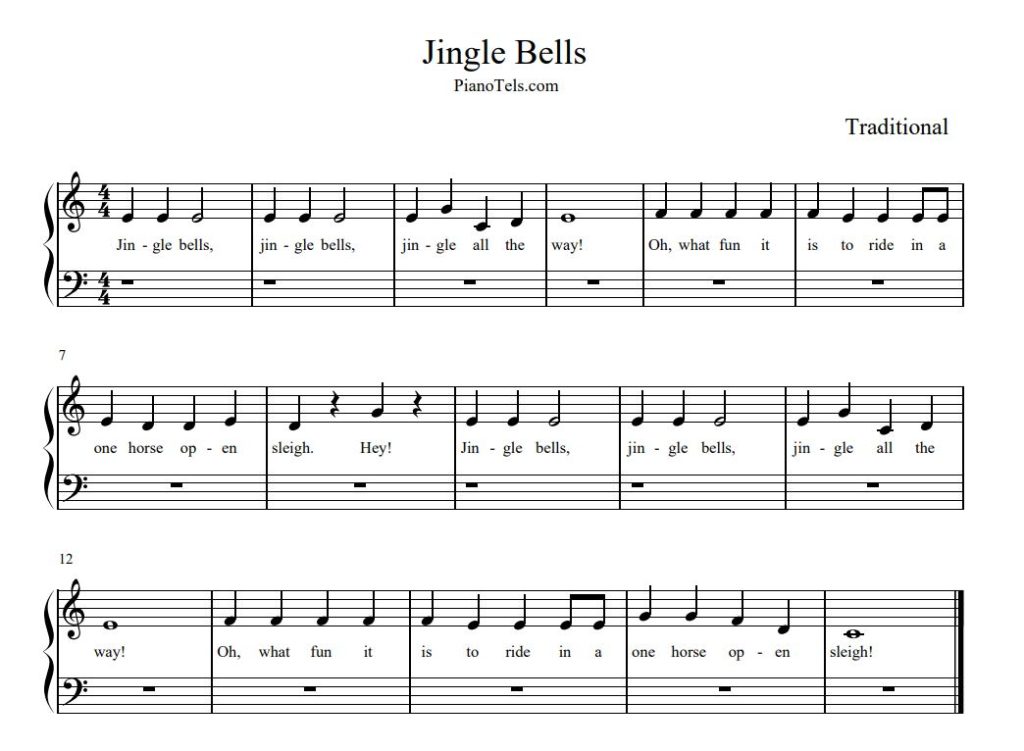
From here, as often as you deem necessary, add in a tonic, subdominant, or dominant chord. Just play it by ear till it sounds right. Or, if you want to get technical, look for notes that are equivalent to your tonic, subdominant, or dominant chords. For Jingle Bells, we are looking for these notes:
- Tonic: C-E-G
- Subdominant: F-A-C
- Dominant: G-B-D
I want to use the inversions like we discussed earlier. I like the way they sound and the way that the left hand can stay fairly stationary when playing. Like this:
Jingle-Bells-with-Chords.pdf (3113 downloads )
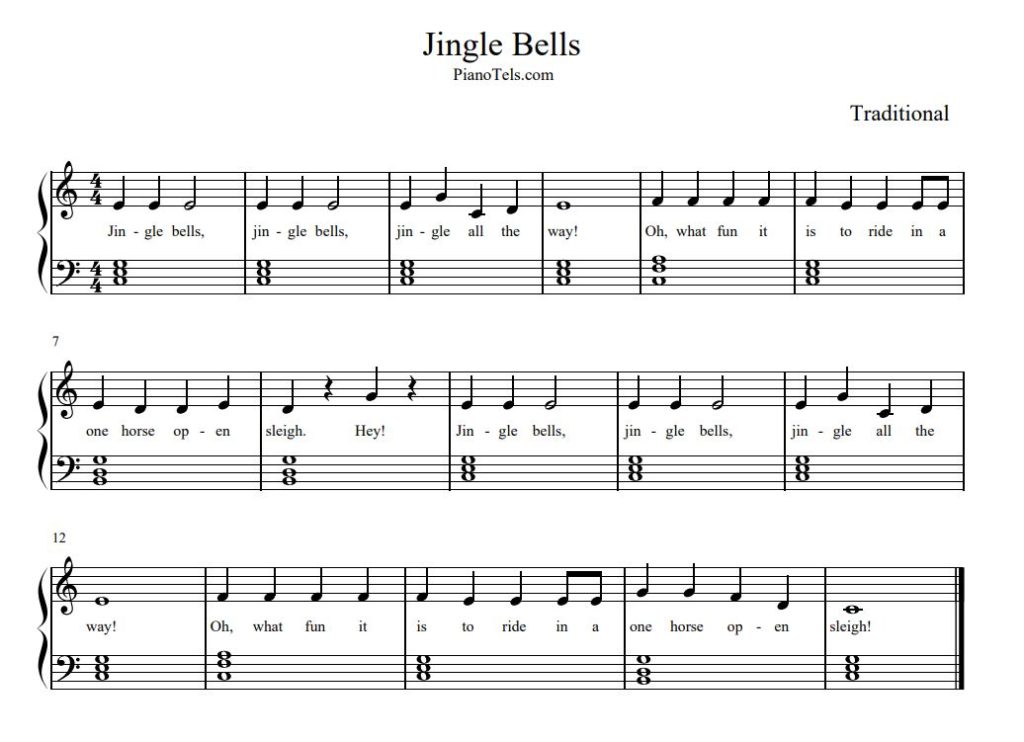
At any time, you can simplify the left hand. Just use any of the notes in the chord that you prefer, or that sound right to you!
Also, try to mix up the chords as well to add some variation. You can use a block chord (as is shown), or a broken chord (playing each note one at a time consecutively), or as an oom-pah chord.
If you want to add even some more pizzaz, here are some other variations from musingsoraministerswife.com: (Numbers represent finger numbers)
- Basic Walking Pattern #1 (1,3,5,6)
- Country Swing Pattern (1,5,6,5)
- Fats Domino #1 (1,8,3,5,3)
- Fats Domino #2 (1,3,5,5,3,5)
- Jerry Lewis (1,1,3,1,5,1,6,1)
- Basic Shuffle Pattern #1 (1&5, 1&5, 1&6, 1&6)
- Basic Shuffle Pattern #2 (1&5, 1&5, 3b, 3, 1&5, 1&5, 1&6, 1&5)
How You Can Improv with Tonic, Subdominant, and Dominant Chords
Try any type of combination of tonic, subdominant, and dominant chords and you can start improving on the spot. Just start a chord progression with any number of variations or combinations, and add a melody!
Jazz players do this, but with minor keys and other scales. You learn the scales, and off you go!
The Magic of Tonic, Subdominant, and Dominant Chords
Hopefully you can now start looking at your music and understanding why they are playing what they are playing and how you can do it too!
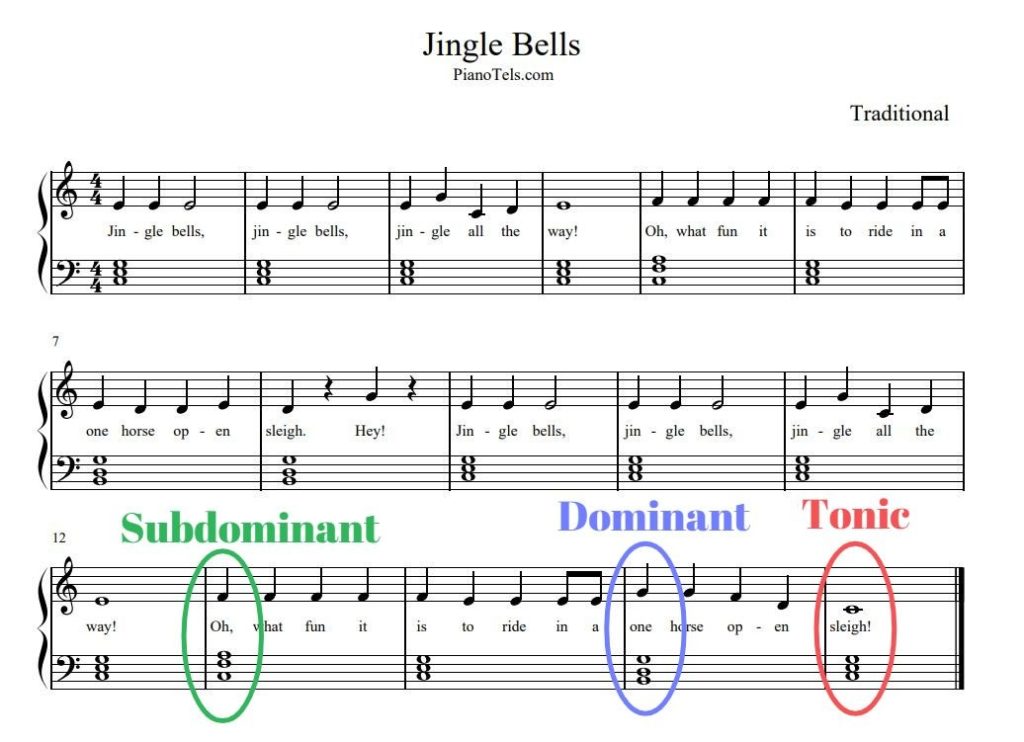
You may be interested in some more colorful and varied version of Jingle Bells. Check it out here: Jingle Bells | Free Easy Piano Sheet Music (Digital Print)
Learn to Play Piano by using Chords
An increasingly popular option for learning piano is using chords to play whatever you want. It is a quick method of learning that can help you go far in your playing. Pianoforall uses this method and has had incredibly positive results.
Pianoforall is an online piano course for a one time, phenomenal price that will benefit them for life as it has free updates for life. It has over 200 videos and lessons, but what piano students will also love is the 9 e-books that let them explore other music styles. You can choose what you want to learn and go for it!
I highly recommend you checking out Pianoforall. It has been used over and over (with over a quarter million students) by piano students since 2006 and it is the best course you can take online for its incredible value. 60 days, money back guarantee, and even then, it has a return rate below 4%. It is extremely affordable with only a one time payment and free updates for life.
Related Articles:
This song is also written with tonic, subdominant, and dominant chords: When the Saints Go Marching In (Free Easy Piano Sheet Music)
Tel loves her life as a piano player, a piano teacher, and a mom. Amid piano blogging, piano teaching, and piano playing, she loves a chance to fit in a good exercise class, volunteer at her kids’ school and at her church, and go on long dates with her husband. Full bio at About Tel.



This article/lesson is confusing. It starts by saying that:
Tonic, dominant, and subdominant are the first, fourth, and fifth degrees in any scale.
This implies that the dominant is the fourth and the sub-dominant is the fifth degree, when in fact the opposite is true. Further down in the article we have:
‘What You Need To Know About Dominant
How do you find the dominant?
The subdominant is the fifth degree of a scale, or can be found 5 tones, or notes above the tonic.’
Presumably the writer intended to to say that the dominant is the fifth degree etc.
It’s just sloppy writing. Cannot believe this hasn’t been pointed out before.
Thanks for the clear and informative article on Tonic, Subdominant and Dominant. I finally understand it better than before. Also I learnt what inversions are too. Very happy.
Thank you so much PianoTels😊
This article is brilliant. The best I’ve seen on the subject. I now understand the subtleties that I didnt before. The criticism from James is a bit harsh. If I was to re-write it I would say, “Absolutely excellent, thanks for taking the time to share. As a helpful contribution to your much appreciated work, please review my comments on a possible mis-typing in your text….
Thanks again ”
Schaun
One of the best articles I’ve found on this subject! Thank you for the details
I appreciate the feedback! Always nice to hear that my work has been helpful for somebody!
Thanks for the article. Also, I think you may have mixed words in the “Dominant” section, where you wrote:
“The subdominant is the fifth degree of a scale, or can be found 5 tones, or notes above the tonic.”
I think you may have meant “dominant”.
Bests.
Thank you for pointing out my typo! I fixed that!
Given what else is written on the ‘net on this subject what you write does make it clear, although it seems to be that it’s practical application is confined to composing or improvising music and that this knowledge isn’t really necessary for playing an instrument or singing. This might go for quite a lot of music theory!
Haha! I guess you could say that. Understanding music theory can help you play or sing better, but there are many out there that don’t understand music theory and they can play or sing quite well!
The image for the Dominant chord in root position in the Bass Clef (DFA) is wrong… please correct! Otherwise, great article
Thanks for the catch in that LH chord on that one pic – got it corrected!
I know little about readying music and even less about composition, but I did find much of this article clear.
In the section called
The subdominant “moves” us up to the dominant.
You wrote:
“As such, you will often find a dominant following a subdominant chord”
Apparently, you don’t mean that the dominant chord follows AS THE VERY NEXT CHORD, because in your example you have circled a subdominant chord (IV) . The very next chord is a tonic chord and only then comes a dominant (V).
So what do you mean when you say a V follows IV?
Also, musingsoraministerswife.com doesn’t exist
( neither does the more logical spelling musingsOFaministerswife.com )
This article is brilliant. The best I’ve seen on the subject. I now understand the subtleties that I didnt before. Absolutely excellent, thanks for taking the time and effort to share it. Much appreciated
Schaun